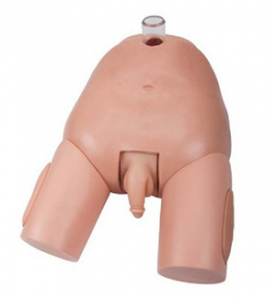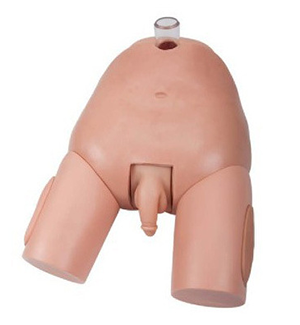
Can the advanced male bladder puncture model meet the learning needs of different students?

In summary, the design of the advanced male bladder puncture model meets the multiple needs of different students for individuation, accuracy and practicability in the learning process. Through a highly restored anatomy, real-time data feedback system, and a variety of operational exercises, this model helps students to master bladder puncture techniques faster and better. Although there may be some challenges in terms of funding and equipment maintenance, its value and role cannot be ignored. With the continuous development of medical education, similar advanced training models will gradually become an important part of medical education, helping medical students and medical personnel to improve clinical operation skills, and providing more possi...

In medical education, the mastery of operational skills is crucial, especially for some difficult and risky operations, such as bladder puncture. With the continuous progress of simulation teaching technology, more and more training models emerge. As an important medical training tool, advanced male bladder puncture model (hereinafter referred to as "bladder puncture model") has become an important resource in the field of medical education. So, is this advanced model able to meet the learning needs of different students?
1. Simulate a variety of clinical scenarios to meet the individual needs of students

Advanced male bladder puncture model
One of the goals of the bladder puncture model is to help students practice in a safe and controlled environment by simulating various complex situations in clinical procedures. For medical students, different levels of students have different needs. For example, for beginners, the model can provide simple, basic exercises in puncture manipulation; For more experienced students, the model can simulate complex pathological situations (such as bladder stones, urethral stenosis, etc.), so that students can practice clinical skills in a more realistic environment. Therefore, the advanced male bladder puncture model is highly adjustable in design and can provide a personalized training program according to the different levels and needs of the trainees.
2. Real anatomical structure, enhance the intuitiveness of learning
The model is based on a highly reproduced male pelvic and bladder structure, using real materials that can be touched, such as replaceable organ layers, to simulate the tactile sensation of actual operation. For medical students, being able to touch and manipulate models that resemble human structures can help them better understand anatomy and processes. This lifelike experience enhances students' sense of control over technology, especially for students with multi-sensory learning needs such as vision and touch, which can greatly improve the intuitiveness and memory of learning.
3. Data feedback system to help students improve operation skills in time
The advanced Male bladder puncture model is equipped with an advanced electronic data feedback system that monitors the student's procedure in real time and provides feedback. This system can record the depth, Angle, force and other key operating parameters of the piercing, so as to help students find their own shortcomings in the process. For example, for students whose piercing is too shallow or too deep, the system will sound an alarm and display corrective suggestions to help students adjust themselves. The data feedback system can not only improve the skill level of students in a short time, but also help the teaching staff to customize a personalized learning plan for each student.
4. Shorten the learning curve efficiently
Traditional medical training often relies on a lot of theoretical learning and limited hands-on opportunities, which can lead to anxiety or improper handling of real patients in the early stages. By using a bladder puncture model, students are able to practice in a simulated environment over and over until they have mastered the exact technique. This process of repeated practice can effectively shorten the learning curve from theory to practice, so that students are more confident in the face of practical clinical operations. According to the data support, after the introduction of advanced simulated human model in some medical education institutions, the operation error rate of students is significantly reduced, and the learning progress is also significantly accelerated.
5. Adapt to a variety of learning styles
Each student's learning style and learning progress are different, especially in the process of mastering medical skills, and individual differences are particularly significant. Through the design of various adjustable parameters, the bladder puncture model can provide suitable training for students with different learning styles. For example, for visual learners, detailed operational demonstrations and feedback can be provided to help them understand the steps; For students with strong hands-on skills, they can strengthen their muscle memory by increasing the number of exercises. Therefore, this model can not only meet the needs of students at different levels, but also meet the personalized learning needs of students with different learning styles.
6. Challenges and opportunities in practice
Despite the many advantages of the advanced male bladder puncture model, there are still some challenges in practical application. For example, the price of the model is relatively high, which may pose a certain financial pressure for some schools or hospitals. At the same time, additional resources are required to maintain and update the model. In addition, although the model highly simulates the real operating environment, it is still not a complete substitute for clinical experience with real patients. Therefore, the use of models should be used as a complement to clinical training, not a complete substitute.
Conclusion
In summary, the design of the advanced male bladder puncture model meets the multiple needs of different students for individuation, accuracy and practicability in the learning process. Through a highly restored anatomy, real-time data feedback system, and a variety of operational exercises, this model helps students to master bladder puncture techniques faster and better. Although there may be some challenges in terms of funding and equipment maintenance, its value and role cannot be ignored. With the continuous development of medical education, similar advanced training models will gradually become an important part of medical education, helping medical students and medical personnel to improve clinical operation skills, and providing more possibilities for future medical practice.

Marketing Center
Hong Kong, ChinaProduction Base
Shanghai, ChinaProducts
Contact Us
 Address: Hong Kong, China
Address: Hong Kong, China
 Phone:+86 19937901373
Phone:+86 19937901373
 Email:sophia@adahealthy.com
Email:sophia@adahealthy.com
 Mobile:+86-0379-65160607
Mobile:+86-0379-65160607








